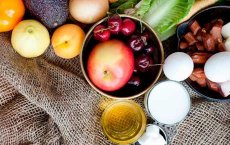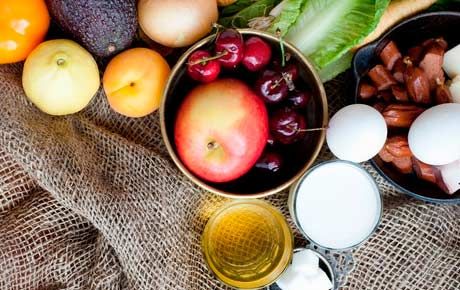Medical expert of the article
New publications
Diet for high hemoglobin
Last reviewed: 04.07.2025

All iLive content is medically reviewed or fact checked to ensure as much factual accuracy as possible.
We have strict sourcing guidelines and only link to reputable media sites, academic research institutions and, whenever possible, medically peer reviewed studies. Note that the numbers in parentheses ([1], [2], etc.) are clickable links to these studies.
If you feel that any of our content is inaccurate, out-of-date, or otherwise questionable, please select it and press Ctrl + Enter.

A diet for high hemoglobin is a simple but effective method of lowering hemoglobin levels to normal values by following certain dietary rules. Let's look at what foods are prohibited and what foods are recommended for high hemoglobin, as well as an approximate menu for the day.
Everyone knows that low hemoglobin levels are very bad, as they can cause anemia. But high hemoglobin levels are also life-threatening. High hemoglobin levels can cause problems with the cardiovascular system, hypoxia, malignant tumors, and other adverse health conditions.

If an adult woman has hemoglobin levels exceeding 140 grams/liter of blood, and a man has 150 grams/liter of blood, then such levels are considered pathological. With such tests, you must immediately seek medical help and follow a special diet. A diet for high hemoglobin is aimed at thinning the blood. For this, products containing heme iron, which is easily absorbed by the body, are recommended. The essence of the diet is a complete change in the usual diet and views on nutrition. Only those products that contain a minimum of iron or do not contain any at all are allowed for consumption.
Diet for high hemoglobin in women
A diet for elevated hemoglobin in women is aimed at reducing hemoglobin to normal levels. High hemoglobin levels in women are extremely rare. The main cause of high hemoglobin is living in high-mountain areas and excessive physical activity. In addition to external factors, hemoglobin is affected by various pathologies of the body. Increased hemoglobin occurs in pregnant women. This occurs due to hormonal changes in the body. During pregnancy, hemoglobin levels can be 150-170 grams/liter of blood. In this case, the woman is prescribed a complex of multivitamins and iron-rich drugs. But before childbirth and in the last months of pregnancy, hemoglobin returns to normal.
The main symptoms of elevated hemoglobin are sleep problems, skin redness, poor health, and high blood pressure. In many women, elevated hemoglobin occurs against the background of gynecological diseases or prolonged and painful menstruation.
The main treatment is diet. It is necessary to exclude foods with a high content of iron, fats and proteins of animal origin from the diet, as these substances cause the formation of cholesterol plaques and blockage of blood vessels. The diet for high hemoglobin in women should consist of fruits, seafood, vegetables and fish. It is forbidden to eat red meat, red berries, cereals. In addition to the diet, it would not be superfluous to take blood thinning drugs (acetylsalicylic acid).
Diet for high hemoglobin in men
Diet for elevated hemoglobin in men is a comprehensive approach to nutrition. In men, hemoglobin increases due to physical activity and prolonged exposure to fresh air. High hemoglobin is a syndrome of climbers, cyclists and other athletes. A hemoglobin level of 140 grams per liter of blood is considered normal. If hemoglobin is 20-50 g / l higher, this indicates a pathology. Hemoglobin can also increase due to smoking, since this bad habit leads to the fact that the tissues do not have enough oxygen. Due to high hemoglobin, strokes and heart attacks occur in the strong half of humanity.
Effective treatment is diet and taking special blood thinning medications (aspirin, trental, cardiomagnyl). The diet should not include foods rich in iron, as well as animal proteins and fats. Preference should be given to vegetables, seafood and fruits. Red meat, buckwheat, red vegetables (beets, carrots) and fats, which lead to the formation of blood clots, are strictly prohibited.
 [ 8 ]
[ 8 ]
Diet for high hemoglobin in children
A diet for elevated hemoglobin in children is a great way to teach a child the basics of healthy eating and normalize hemoglobin levels in the baby's blood. Elevated hemoglobin in a child can occur due to blood diseases, cancer, cardiovascular or pulmonary insufficiency, heart defects and other pathologies. The main symptoms of elevated hemoglobin in a child are drowsiness, pale skin or its sharp reddening, fatigue.
Treating elevated hemoglobin levels requires diet. Since high blood cell counts are the cause of blood clots and vascular occlusion. Children are prohibited from taking medications that thin the blood, so all attention during treatment should be focused on the child's diet. Ensure proper drinking regimen. It is necessary to drink a lot of water, as this will dilute the blood and hemoglobin. It is prohibited to eat foods with a high iron content, as they will provoke an increase in hemoglobin. You should give up red berries, cereals, liver, and red meat. The basis of the diet should be such products as chicken, fish, plant foods, soy and legumes.
Sample menu for high hemoglobin
An approximate menu for elevated hemoglobin allows you to adjust your diet to normalize hemoglobin levels in the blood, both in adults and children. We offer you an approximate menu for the day, which can be used as a basis for nutrition to lower hemoglobin in the blood.
Breakfast
- Rice casserole.
- Green tea or a glass of apricot juice.
Snack
- A handful of nuts.
- Whole grain breads.
Dinner
- Pea soup.
- Homemade noodles with tofu cheese and baked fish.
- Green tea.
Snack
- Grape.
- Whole grain breads.
Dinner
- Chicken breast (boiled) and spinach.
- Apricots.
- Green tea or cocoa.
A diet for high hemoglobin is an opportunity to restore normal functioning of the circulatory system without significant harm to the body. A couple of weeks of dieting and your hemoglobin is back to normal!
What foods can you eat if you have high hemoglobin?
With elevated hemoglobin, it is very important to know what foods you can eat, since the main treatment is diet. First of all, it is necessary to minimize the consumption of animal protein, that is, to give up red meat and liver. The lack of protein can be replenished with products such as soy, chicken and legumes. The diet involves giving up fatty foods. The diet should include a lot of fish, seafood and products with a high content of polyunsaturated fatty acids Omega-3 and 6. These products strengthen the walls of blood vessels and thin the blood.
In addition to nutrition, taking vitamin complexes will help normalize hemoglobin levels. But vitamins should be prescribed by the attending physician, since many vitamin complexes are aimed at increasing hemoglobin levels.
What foods should you not eat if you have high hemoglobin?
When following a diet to normalize hemoglobin levels, you need to know which foods you can't eat, as they can cause abnormal hemoglobin levels and harm the body. First of all, you need to give up alcohol; any alcoholic beverages are prohibited with elevated hemoglobin. Fish and seafood are rich in heme iron, but when following a diet, it is recommended to boil and bake fish, but not eat it raw, dried or smoked.
Sweets and foods with high sugar content are also prohibited. You will also have to give up red meat, you can only eat chicken and turkey. You cannot eat red berries, fruits and vegetables, as they contain substances that stimulate the growth of hemoglobin. Everyone's favorite apples are also prohibited, as they are rich in iron. Only a doctor or nutritionist can say for sure which products are prohibited for consumption, after studying the blood test.

